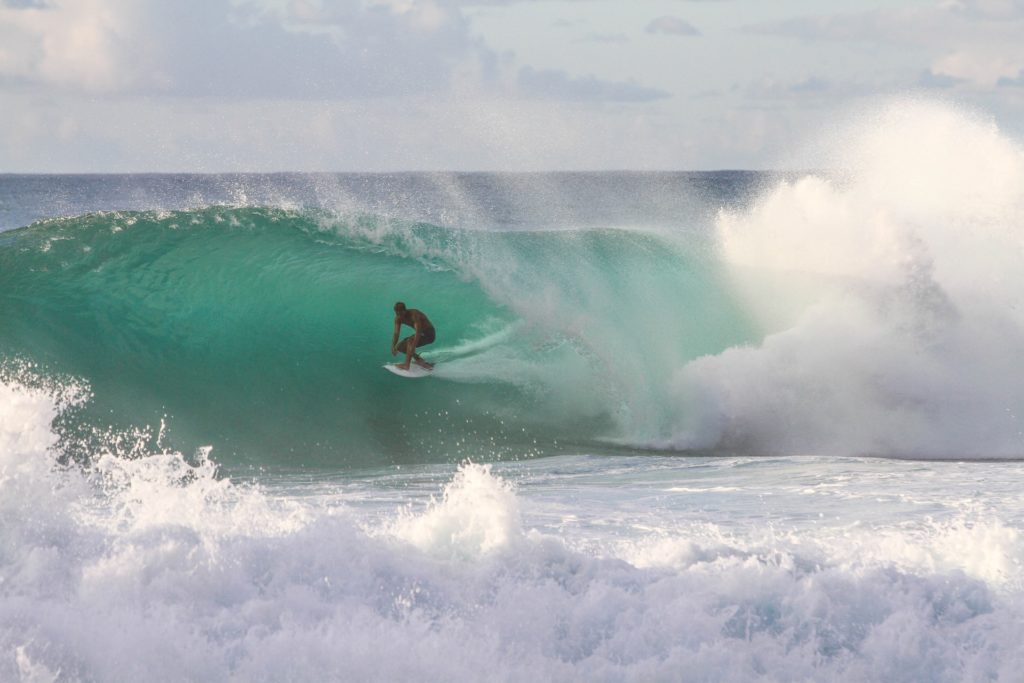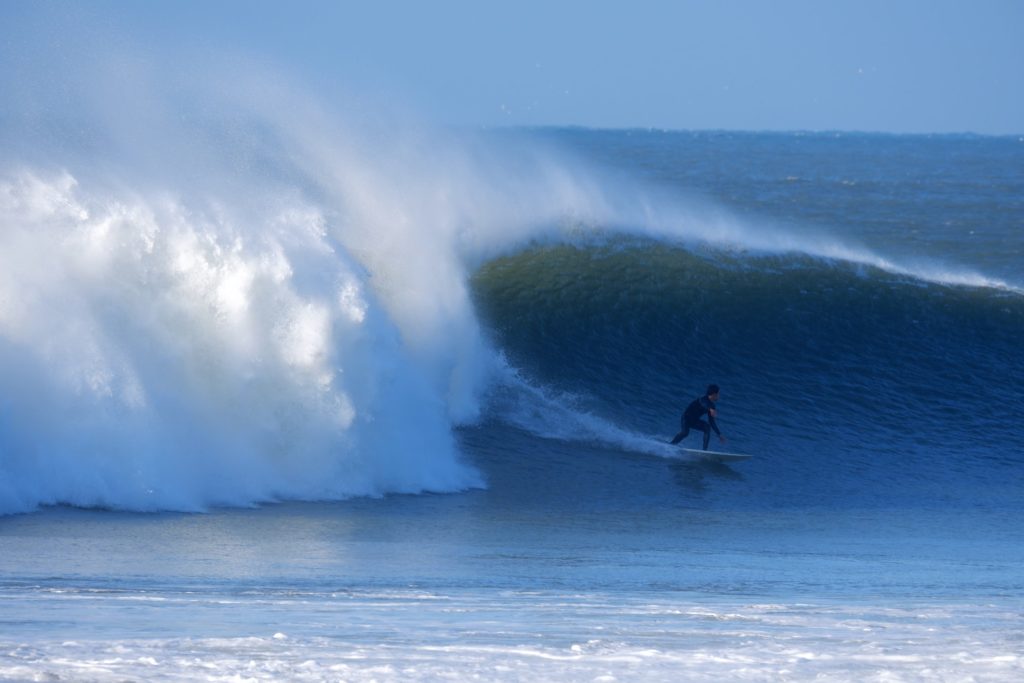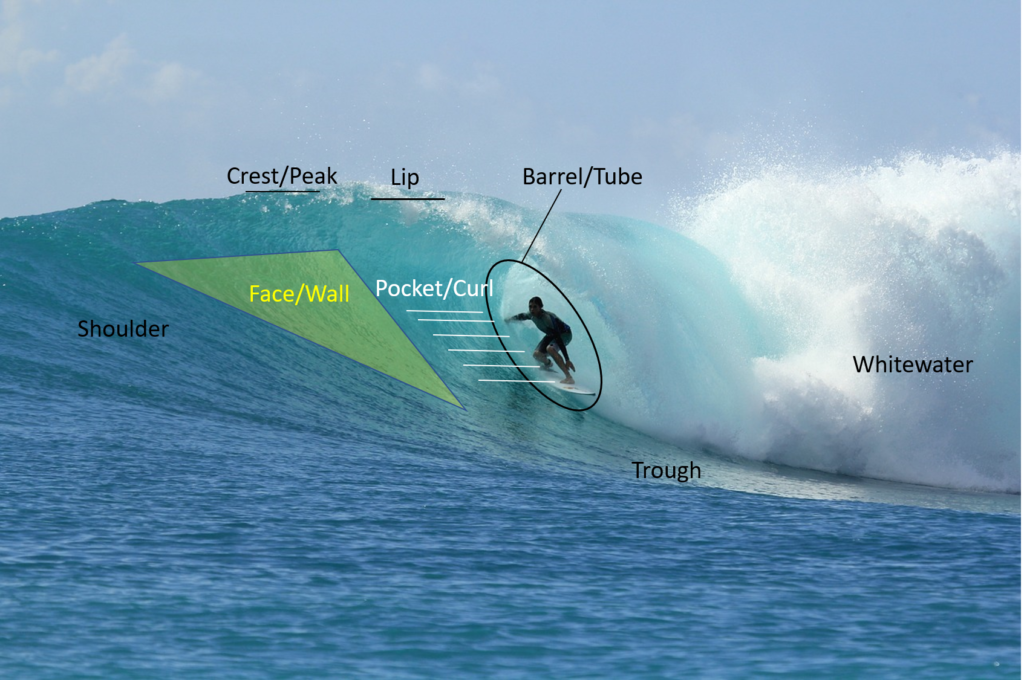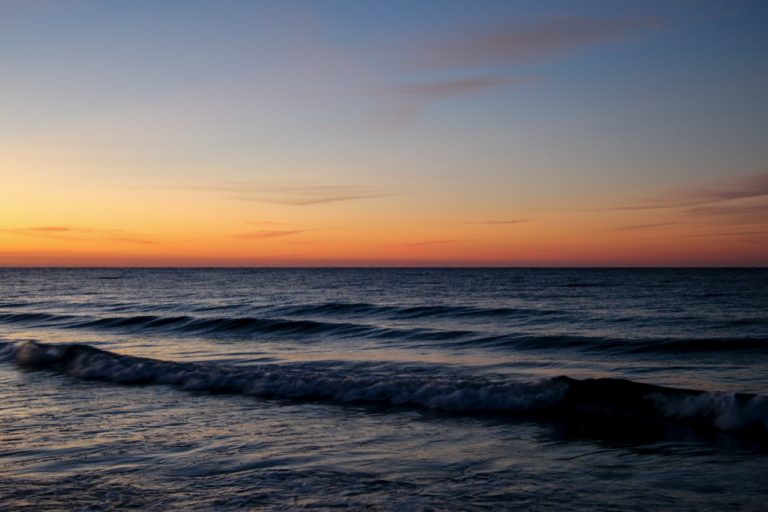Surf Glossary Table of Contents
Wondering what surfers say when the waves are good? Not sure if you’re being made fun of? You’re in the right place. Click the links below to skip to specific sections of the glossary, or just scroll ’til you find the term you’re wondering about.
Surfing slang
Surfing jargon
Surfing slang
Violating surfing etiquette
As a surfer, you have to give respect to get respect. And when you’re disrespectful, you’ll get shamed—or (much) worse. Here are the slang terms surfers use to describe etiquette violations:
Snake: When a surfer deliberately paddles inside of another surfer at the last minute to take off deeper and steal the priority position This is frowned upon.
Backpaddle: to paddle past a surfer(s) towards the takeoff zone even if it’s not your turn, the surfer’s equivalent of cutting in line.
Burn, Drop-in: when one surfer takes off on a wave that another surfer is already up and riding.
Getting barreled

Getting barreled is a surfer’s nirvana. So it’s no surprise that 14 terms refer in some way to barrels and getting barreled:
Pitted, Shacked, Slotted, Barreled: riding inside the barrel of a wave.
Tube, Pipe, Barrel: the hollow part inside of a wave
Pull in: when a surfer positions himself into the barrel of a wave e.g. “He pulled into the barrel.”
Spat out: being ejected from the barrel of a wave e.g. “He was fully barreled and then got absolutely spat out.”
Spitting: a barrelling wave that ejects a strong blast of mist and water from the barrel is said to be “spitting”
Cover-up: another term for getting barreled e.g. “He’s all covered up!”
Green room: the name for the space inside of the wave when you’re fully barreled.
Keg: a barrel
Tubular: describing a wave that forms a tube-like shape.
Wiping out
Every wave is different, which means you can wipe out in many different ways. Naturally, there’s a lot of slang dedicated to describing different kinds of surfing wipeouts:
Over the falls: when a surfer is taken by the lip of the wave and thrown from the top to the bottom of the wave. This happens because of a failed duck dive on a big wave or when a surfer tries to pull back off of a wave too late.
Pearling: when the nose of the board dives into the water i.e. nose dive.
Rag dolled: Being tumbled around by a wave.
Tombstone: when a surfer is being held under by a wave sometimes their board pops up and bobs up and down vertically, this generally only happens in really big waves.
Took it on the head: A way of saying that wave crashed on you. It doesn’t necessarily have to mean the wave crashed directly on your head. “I took the one on the head” or “I took that entire set on the head.”
Washing machine: Getting tumbled underwater by a wave.
Worked: being pummeled by a wave.
Bail: to fall off a surfboard intentionally i.e. “I wasn’t going to make it so I bailed”.
Derogatory slang
Surfers are notorious gatekeepers, and we have a lot of derogatory, slang terms to put others in their place:
Aggro: an aggressive person.
Quimby: a surfer who is always trying to catch a wave but never actually catching one.
Shoobie: a tourist who comes to the beach for a day trip and gets in the way of surfers.
Barney: a beginner surfer.
Benny: a beginner surfer.
Buoy: A surfer who sits out in the lineup but doesn’t catch any waves. You probably won’t hear this term anywhere but here because my brother and I made it up.
Hodad: a non-surfer who tries to act like one.
Kook: an inexperienced or disrespectful surfer. Read more on kooks.
Namer: A surfer who names where they surf, esp. to a large audience (e.g. on social media), which is frowned upon. Surfline, the forecasting app, is the ultimate namer.
Noodle arms: a surfer who is unable to paddle well.
Wave hog: A surfer who takes more than their fair share of waves.
Big waves

Big waves inspire both awe and a particular brand of surf lingo. Here’s the big wave surf slang:
Bomb: a name for a big wave.
Heavy: powerful, dangerous waves.
Macking: large, powerful waves; similar to “firing” but more likely to describe big waves whereas “firing” could just mean the waves are good but not necessarily big.
Maxed out: when the swell is so big that the waves it created are closing out and unrideable, e.g. the beach breaks are maxed out on this swell but it should be rideable at breaks with some structure.
Good waves
Seven things surfers say when the waves are good:
Pumping: waves that are particularly good for surfing i.e. “the waves are pumping, let’s get out there.”
Feathery: refers to the ocean spray that comes off the lip of a wave when the winds are blowing offshore.
Firing: waves that are particularly good for surfing.
Going off: a surf spot with particularly good waves.
Nug: short for “nugget” which means a high-quality wave.
Throwing: a wave that is breaking with a lot of force.
Surf’s up: a phrase used to announce that the waves are good for surfing.
Surfers might also describe good waves as sick, radical, hollow, tubing, spitting, barrelling, macking, or clean.
Bad waves
Ankle slappers: small, weak waves.
Fat: waves that are not breaking with a lot of power.
Gutless: describing waves that are not breaking with a lot of power.
Slop: Low-quality waves.
Soft: waves that aren’t breaking with a lot of power.
Mushy: waves that are not breaking with a lot of power.
Wobbly: refers to waves with choppy faces, typically caused by backwash or cross-shore wind.
Miscellaneous slang for waves and conditions
Drained: when there’s a very low tide, the opposite of swamped.
Swamped: when there’s a very high tide, the opposite of drained.
Glass off: when previously rough surface conditions become smooth or “glassy.”
Glassy: smooth ocean conditions. Surfers love glassy waves.
Gnarly: difficult or dangerous surfing conditions caused by any number of hazards e.g. sharks, strong currents, heavy waves, rocks, etc.
Jacking, Kicking Up: a wave that is rising, increasing in height and steepness.
No man’s land: The area in front of where the waves are breaking, also known as the impact zone or “inside.”
Wall: a vertical or near-vertical wave face. Depending on the context, this can be good (a rippable wall) or bad (close out).
Wobbly: refers to waves with choppy faces, typically caused by backwash or cross-shore wind.
Surfing gear
Asym: an asymmetrical surfboard.
Blade: used as a general term for a surfboard but may also refer specifically to a high-performance shortboard.
Sled: another name for a surfboard.
Ding: damage to your surfboard.
Glider: a type of longboard that’s over 9′.
Log: another word for a longboard.
Mal: another name for a longboard that’s over 9′.
Mini Mal: another name for a midlength surfboard.
Overgunned: using a surfboard that is too large for the size of the waves.
Quiver: a surfer’s collection of surfboards; you can have a one, two, three or fifteen-board quiver.
Skeg: an old-fashioned slang term for fin.
Sponge: another word for a boogie board.
SUP: stand-up paddleboard.
Twinnie or twin fin: a surfboard with two fins, one on each side of the tail.
Undergunned: using a surfboard that is too small for the size of the waves, as in “The waves were big and I was undergunned so I had trouble catching anything.”
Wall hanger: a surfboard that’s so beautiful it shouldn’t be surfed and should instead be used as decoration.
Leggie: leash.
Steamer: an Aussie slang term for a winter wetsuit.
Wettie: slang for wetsuit.
Other slang
Cowabunga, Yew: an exclamation of excitement or approval.
Radical: extreme or impressive.
Bogging: sinking your rail.
Charging: surfing aggressively or with determination.
Cheater five: riding a wave with all body weight back from the front of the board and sticking one foot out to reach five toes of one foot off the front of the board rather than standing at the front of the board with five toes hanging.
Dragging corn: an Aussie slang phrase for sticking your butt in the face of the wave while riding it.
Knifed: dropping into a steep wave e.g. “I knifed the takeoff right into the barrel”.
Locked in: when a surfer is in a good position on a wave and able to ride it easily.
Rock dance: the funny walk surfers have to do when they’re walking on rocks to get into or out of the water.
Scratch: to paddle hard to catch a wave or get past a wave that’s about to break on you.
Core lord: a highly skilled surfer who has dedicated their life to surfing but still has a healthy perspective on life. The opposite of a Surf Nerd, according to Jed Smith. .
Grom, Gremmie: a young surfer. (Read more: What is a grom?)
Legend: a highly respected surfer.
Ripper: A highly skilled surfer. For reference, every Core Lord is a ripper but not every ripper is a Core Lord.
Amped, Frothing, Stoked: very excited.
Get wet: To go surfing e.g. “The waves look good if you’re trying to get wet.”
Howzit: a greeting, similar to “how are you.”
Man in the gray suit: a shark.
Surfing jargon
Surfboards and fins

Crease: a type of damage to a surfboard characterized by a ridge of folded fiberglass.
Deck: the top of a surfboard.
Five fin: a surfboard with five fins, four on the sides and one on the tail.
Funboard: a type of surfboard with a medium length and width designed to be fun and easy to ride in a variety of conditions.
Groveler: a type of surfboard with a short, wide shape, designed for use in small waves.
Gun: a long, narrow surfboard designed for riding big waves.
Longboard: a type of surfboard with a long, wide shape. Depending on who you ask, a longboard is any surfboard that’s not a gun that is 8 feet or longer.
Midlength: a type of surfboard with a medium length and width. Depending on who you ask, a midlength is any surfboard that’s not a gun that is between 6’8″ and 8′ feet or longer.
Pintail: a type of surfboard with a pointed tail.
Quad: a surfboard with four fins, two on each side with no center fin.
Rails: the edges of a surfboard.
Rocker: the curve of a surfboard from nose to tail.
Shortboard: a type of surfboard with a short, narrow shape designed for use in more powerful waves.
Single fin: a surfboard with a single center fin.
Squash tail: a type of surfboard with a rounded tail.
Thruster: a surfboard with three fins, one at the center and two on the sides.
Surfing maneuvers
Airdrop: a variation of a normal drop in which the surfer’s board becomes airborne. Check out Kelly Slater’s massive airdrop in competition in the video below:
Backside: surfing with your back facing the wave.
Bottom turn: a turn made by a surfer at the bottom of a wave.
Carving: turning sharply on a wave using the rail of the surfboard.
Caught inside: Being caught by a breaking wave and unable to get out of the impact zone.
Cutback: A maneuver in which the surfer turns sharply back towards the peak of the wave.
Drop: The motion of getting onto a wave from the peak at the beginning of your ride. Drops can be steep, late, or early.
Drop knee: a maneuver where the surfer drops down to one knee on the board.
Duck dive: A maneuver used to get under and past a breaking wave. The surfer pushes the nose of their board into the water with their arms and the tail with their foot.
Floater: A maneuver in which the surfer turns up the wave and rides on top of the breaking whitewater. Check out this massive one in competition:
Foam climb or whitewater climb: A maneuver in which the surfer turns up the wave to ride the whitewater of a broken section of the wave. This might sound similar to a floater, but it’s not the same. In a foam climb, the surfer turns up the wave to “climb” the white water whereas with a floater the object is to glide on top of the whitewater. Check it out in this video:
Frontside: surfing with your front facing the wave.
Glide: to ride smoothly along the face of a wave in a straight line.
Goofy: A surfing stance in which the right foot is forward.
Hang five: riding a wave with five toes hanging off the front of the board.
Hang ten: riding a wave with all ten toes hanging off the front of the board.
Head dip: an old-school move in which the surfer dips their head into the face of the wave. .
Kick out: to ride up and out through the back of the wave and end your ride e.g. “I saw the wave was about to close so I kicked out.”
Layback: a maneuver where the surfer leans back while executing a cutback so their trailing arm and/or back is submerged in the face of the wave.
Nose riding: riding on the front, or nose, of a surfboard.
Party wave: a wave that is shared by multiple surfers.
Pigdog: a surfing maneuver that’s executed riding backside where the surfer drops their back knee, grabs the surfboard’s rail with their outside hand and drags their inside hand as well as their hip and butt in the face of the wave. Further reading (link to history of Pigdog).
Pop-up: The motion of getting up on a surfboard.
Re-entry: a surfing maneuver where the surfer re-enters the wave.
Regular: A surfing stance in which the left foot is forward.
Stall: slowing down or stopping on a wave.
Take off: the motion of getting onto a wave from the peak.
Top turn: a turn made by a surfer at the top of a wave.
Trim: to ride smoothly along the face of a wave in a straight line.
Turtle roll: A maneuver used to get under and past a breaking wave on a longer board. The surfer rolls off the board and under the wave while holding onto the board then rolls back onto the board.
Wave jargon
Parts of a wave

Lip: the top part of a breaking wave.
Crest, Peak: the top of a wave.
Pocket, Curl: the part of a wave under the lip; this is where the wave is breaking the most powerfully and it’s where the best surfers spend most of their time.
Wave face, Wall: the unbroken part of the wave in front of the whitewater where the surfer executes their maneuvers.
Foam ball: the white water churning under the lip of a wave.
Shoulder: the part of a wave that is not breaking.
Whitewater: the foamy, churning part of a wave
Barrel/Tube: the hollow part of a wave that forms a tunnel-like shape.
Trough: the lowermost part of the wave
Section: a segment of a wave, one wave can have multiple “sections” with differing characteristics; a wave could start off slow and fat and then kick up to become steep and fast.
Types of waves and breaks
A-frame: a wave that breaks in both directions, creating an A-shaped peak.
Left: a wave that breaks to the left, from the surfer’s perspective.
Right: a wave that breaks to the right, from the surfer’s perspective.
Break: an area where waves are breaking.
Closeout: a wave that breaks all at once, making it difficult to ride. Read more about closeout waves, including how to ride them.
Double up: when two waves join to create a larger wave.
Peeling: when a wave is breaking in a smooth, organized way.
Point break: a type of surf break formed by a wave breaking alongside a headland.
Racy: a wave that is breaking with a lot of speed and power.
Reef break: a type of surf break formed by a wave breaking over a coral reef or other submerged structure.
Reform: a type of wave that dies down and then breaks again after “reforming.”
Shore break: waves that break close to or on the shore.
Waves conditions
Hollow: describing a wave that is pitching and forming a large “hollow” barrel or tube.
Lull: a long time with no waves.
Messy: rough, choppy waves.
Overhead: a wave that is breaking at least as high as the surfer’s head.
Peeling: when a wave is breaking in a smooth, organized way.
Double overhead: a wave that is breaking twice the height of the surfer’s head.
Clean: Used to describe surface conditions when the ocean is smooth. This happens when there’s little to no wind.
Groomed: Used to describe surface conditions when the ocean is smooth. This happens when the wind is blowing offshore and smoothing out the ocean.
Blown out: waves that are choppy and difficult or impossible to surf.
Choppy: rough ocean surf conditions caused by high winds, mixed-up swells, and/or strong currents.
Cross-shore: referring to the direction of the wind; on a coastline that faces the west, north and south winds are cross-shore.
Offshore: referring to the direction of the wind; on a coastline that faces the west, east winds are offshore and vice versa.
Onshore: referring to the direction of the wind; on a coastline that faces the west, west winds are onshore and vice versa.
Steep: a wave that has a sharp slope.
Triple overhead: a wave that is breaking three times the height of the surfer’s head.
Spaces, areas, zones
Channel: a deeper part on one or both sides of a surf break where the water is calm or flowing out to sea.

Caught inside: Being caught by a breaking wave and unable to get out of the impact zone.
Impact zone: the part of a surf break where the waves are breaking.
Deep: the part of a surf break where the water is deeper, used to describe the position of a surfer or wave that’s further out from the shore e.g. the farther I am from shore, the “deeper” I am.
Inside: the part of a surf break where the waves are breaking.
Outside or out the back: the part of a surf break where the waves are not breaking.
Lineup: the area where surfers wait for waves.
Take-off spot: the area where the wave peaks; not all breaks have defined take-off spots and there may be multiple take-off spots.
Other wave jargon
Set: a group of waves.
Clean-up set: a particularly large set that breaks behind the lineup–where most surfers are sitting–and washes all the surfers in.
Backwash: waves that move away from the coast and out to the ocean.
Shape: the overall form or appearance of a surfboard or wave; can also be used as a verb when referring to “shaping” a surfboard.
Lines: swell before it turns into a wave e.g. “daamn you see those lines coming in?”.
Miscellaneous surf jargon
Rip current: a strong current flowing out to sea through the surf zone which is a hazard to surfers and swimmers.
Riptide: very strong currents that occur as the tide pulls out of an inlet, often confused with a rip current.
Bodyboarder: a person who surfs on a bodyboard.
Bodysurfer: a person who surfs without a board, using only their body to ride the waves.
Local: a surfer who frequently surfs at a particular surf break.
Claim: to celebrate after a good wave.
Dawn patrol: an early morning surf session.
Localism: the systematic oppression of any surfer that is not deemed a local.
Localized: the description for a place that has especially high incidences of localism; at a very localized break, you’ll get very little respect if people don’t know you.
Priority: the surf equivalent to a driver’s right of way.
Session: a period of time spent surfing.
Shaka: a hand gesture made by extending the thumb and pinky finger, symbolizing the “hang loose” mentality of surf culture.
Strike mission: a short trip to a specific surf spot to catch good waves.
